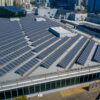(Estimated reading time: 5 minutes) – Audio version of article available.
The strategies to adapt to climate change are just as important as the measures to fight it. There is a huge worldwide effort being made to keep the planet’s average temperature increase at less than 1.5ºC above preindustrial numbers. However, and at the same time, we must also prepare ourselves to face the impact the Earth is now suffering from the 1.1ºC increase (WMO, 2019) already on record, with effects that can no longer be avoided and that will be felt in upcoming years.
Adaptation measures help humanity to fight heatwaves and temperatures much higher than the average (as in Madrid last July (AEMET, 2020)), the effects of flooding, the impact on harvests and the consequences of natural disasters caused by climate change, which take a toll both in social and economic terms and in terms of health. In short, the idea is to reduce our vulnerability.
In this regard, renovating buildings is essential. They are a key factor of human life. Buildings can protect us from heat and cold, and at the same time, they are one of the elements most exposed to the harshest impacts of climate change, such as flooding or natural disasters. Moreover, “guaranteeing access for all to adequate, safe and affordable housing and basic services” is one of the United Nations’ Sustainable Development Goals.
Age and efficiency are important factors when assessing the vulnerability of buildings and the adaptation measures to take. However, in addition to the building’s specific conditions, determining factors also include geographic location and aspects such as the lack of green spaces which, especially in urban zones, contributes to “heat island” situations, or elevated temperatures in city centres caused by mass edification, asphalt and other materials that accumulate heat, then radiate it, normally at night.
In adapting constructions, wall and window-insulation measures are a general priority. For flooding, in addition to temporary barriers and leak-tightness, it is essential to replace traditional materials with other more water-resistant materials, such as steel skirting and solid floors. We might also consider possibly reducing damage with detachable or replaceable doors and moving the location of plug-ins and electric appliances.
For storms, the building structure must be reinforced, replacing gutters and drains with other larger ones. And in areas where drought is a problem, good solutions include installing rainwater collection and wastewater recycling systems, as well as consumption-reduction measures.
For heatwaves, fans, which are cheaper, are an alternative to air conditioning in the home, given that air conditioners contribute to the “heat island” phenomenon. Another solution is to use sun protection elements (awnings, slats, blinds) and cross-ventilation and vegetation (University of Granada, 2018 / Climate Just).
This all counts in fighting climate change, because buildings are one of the elements that most contribute to heating our planet: they are responsible for 40% of end energy and one-third of CO2 emissions (European Commission, 2020). This is why it is also important to incorporate measures for renewable and efficient energy.




